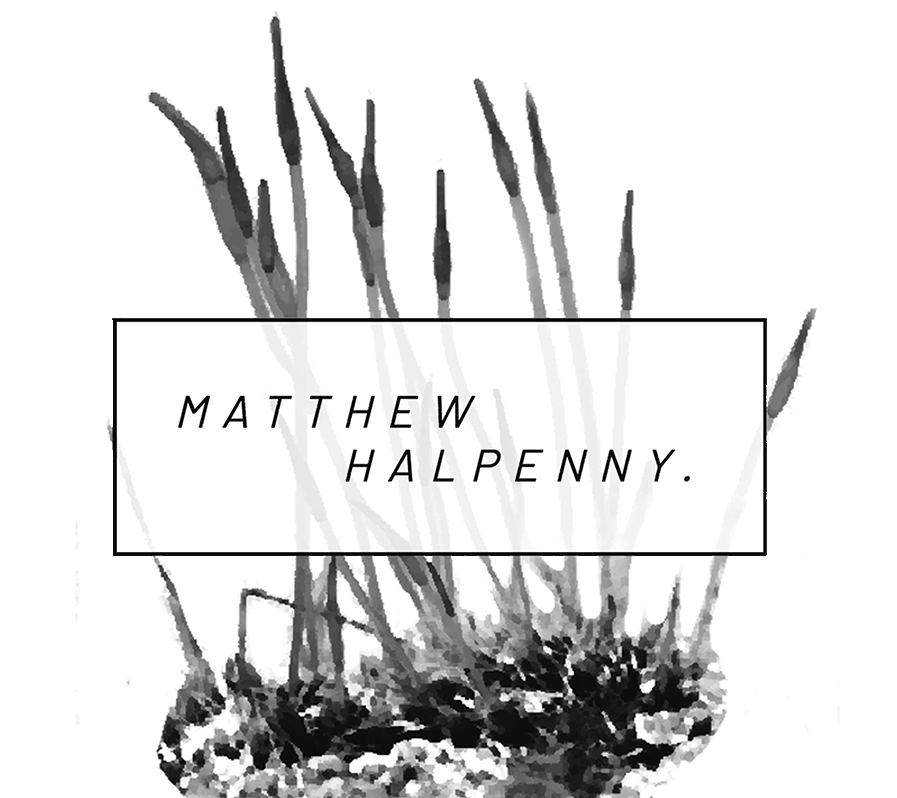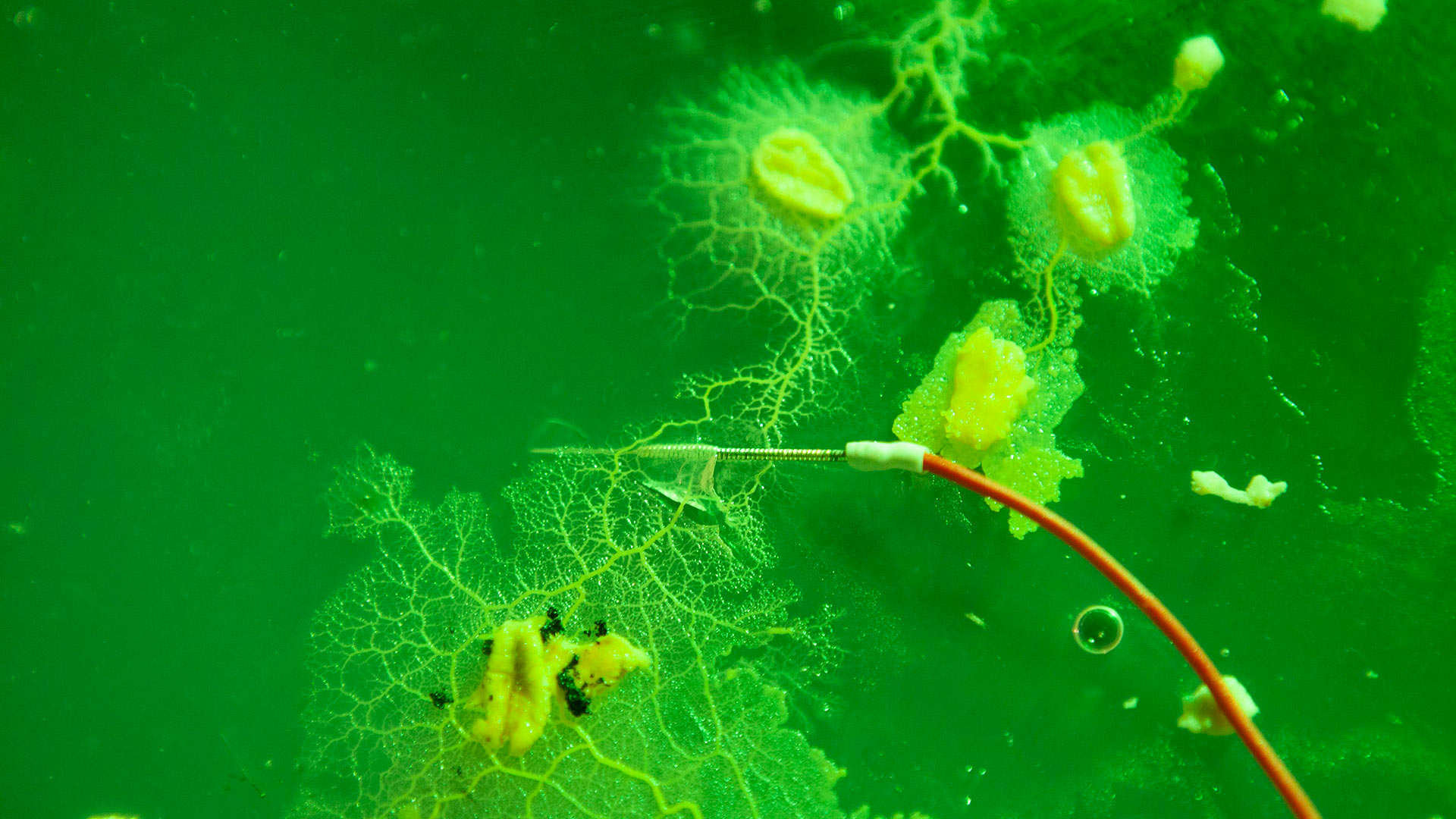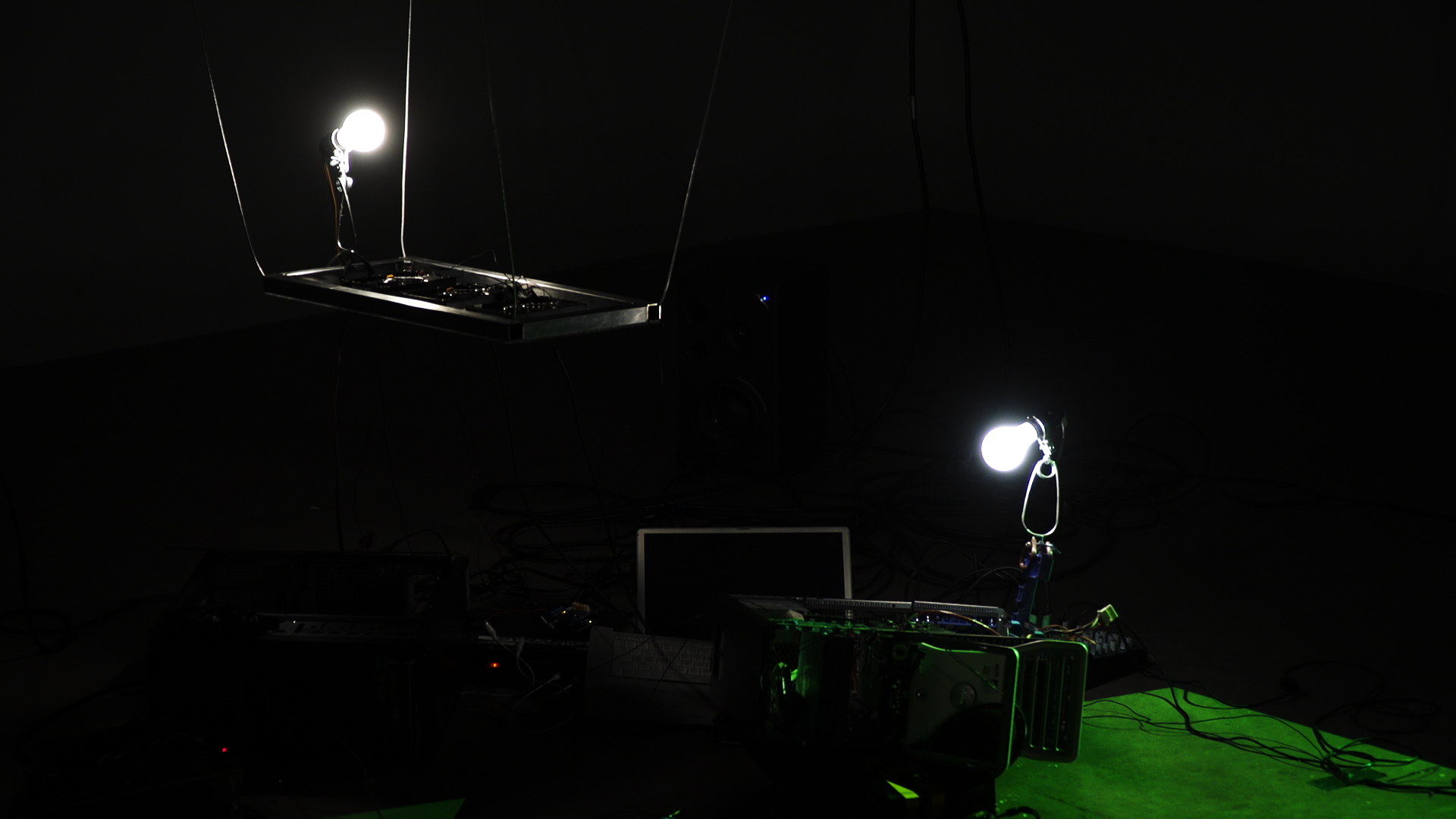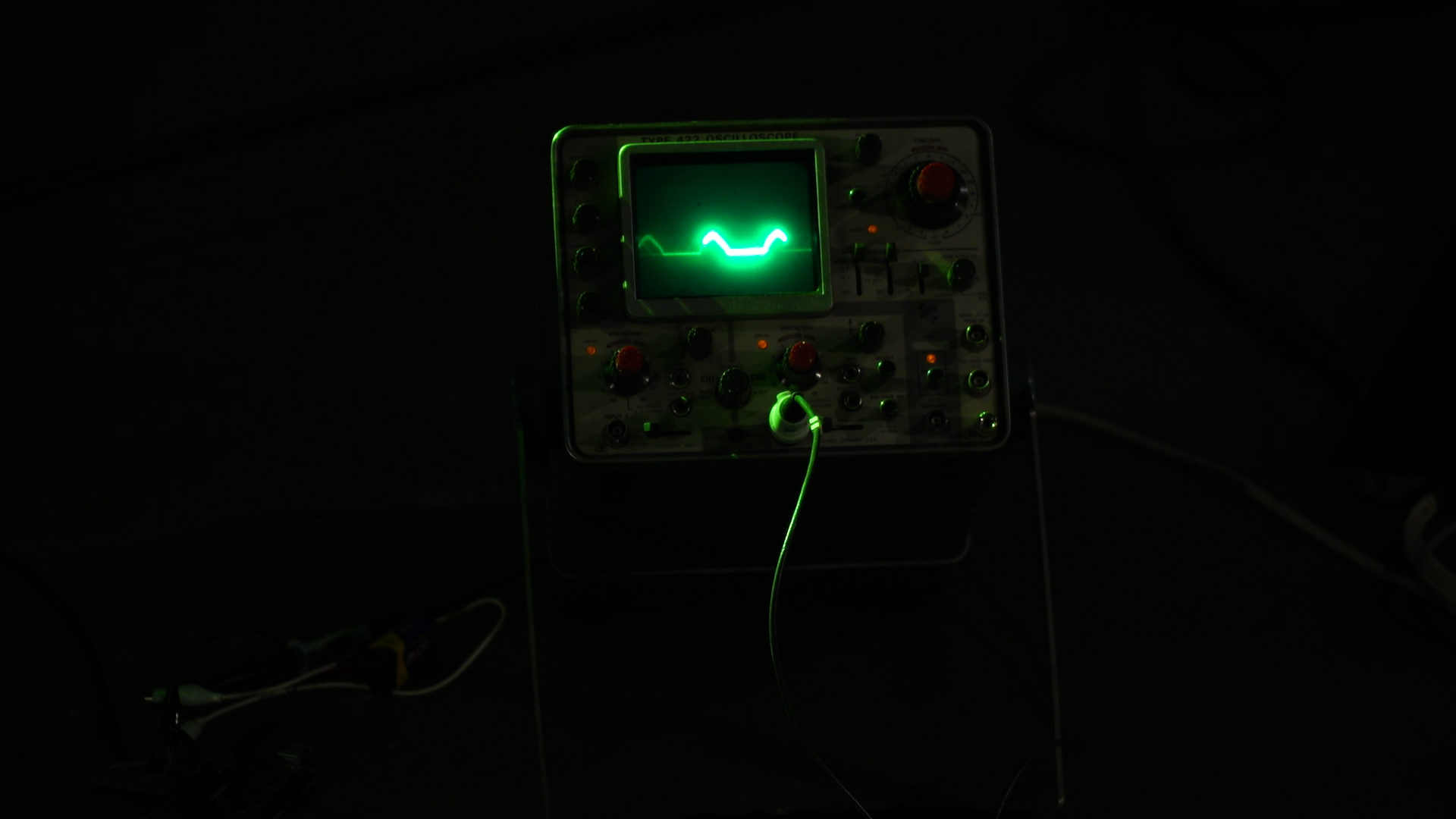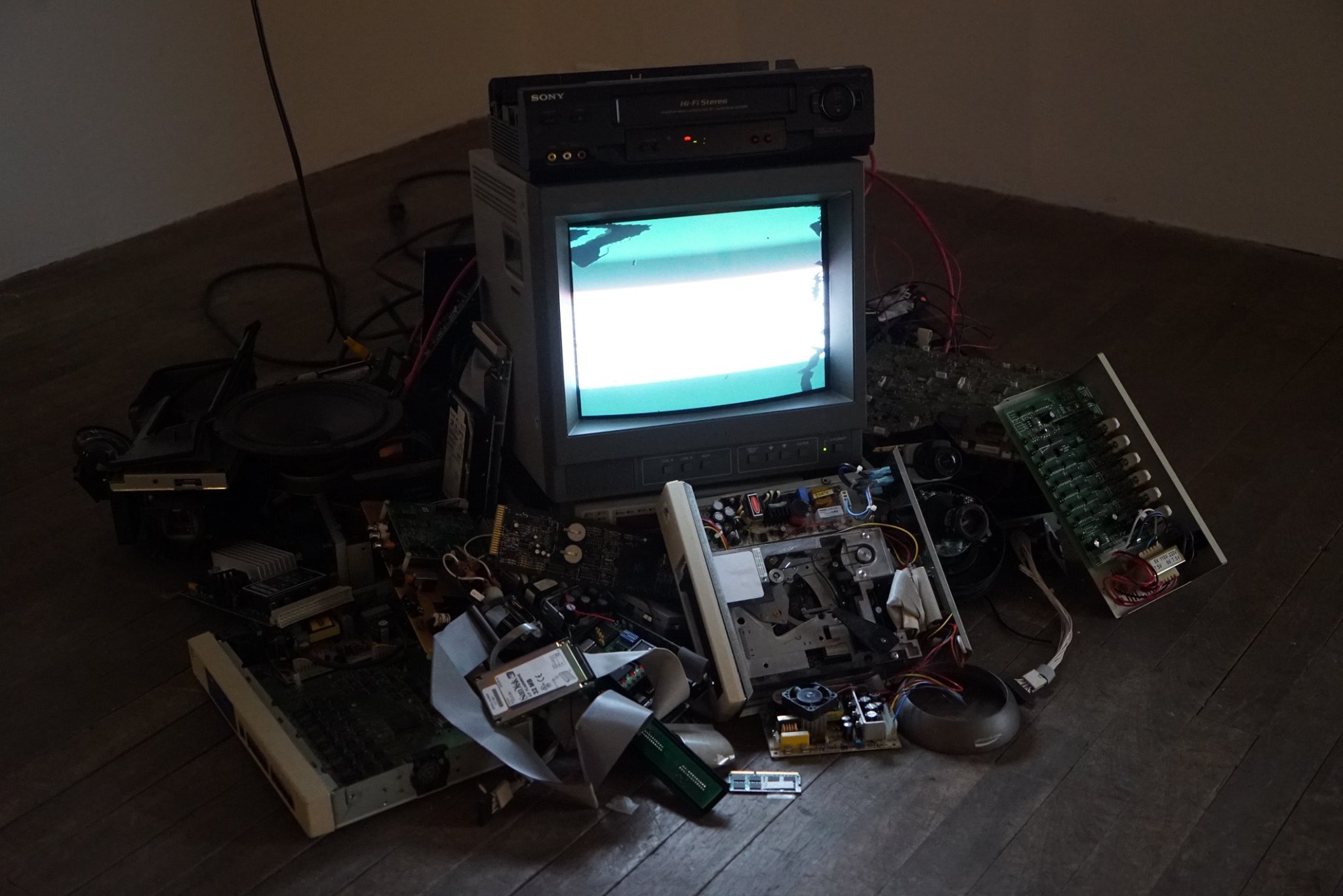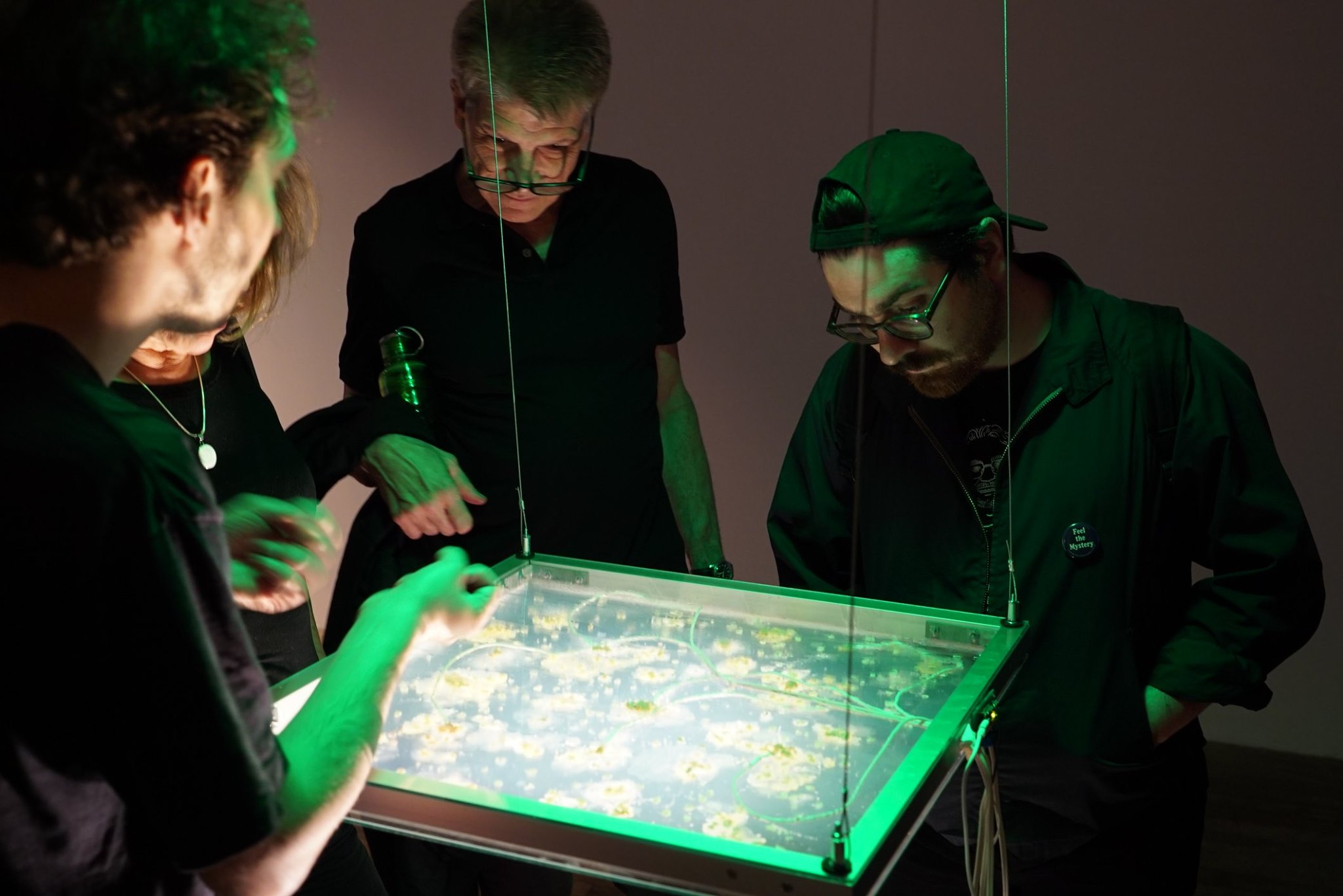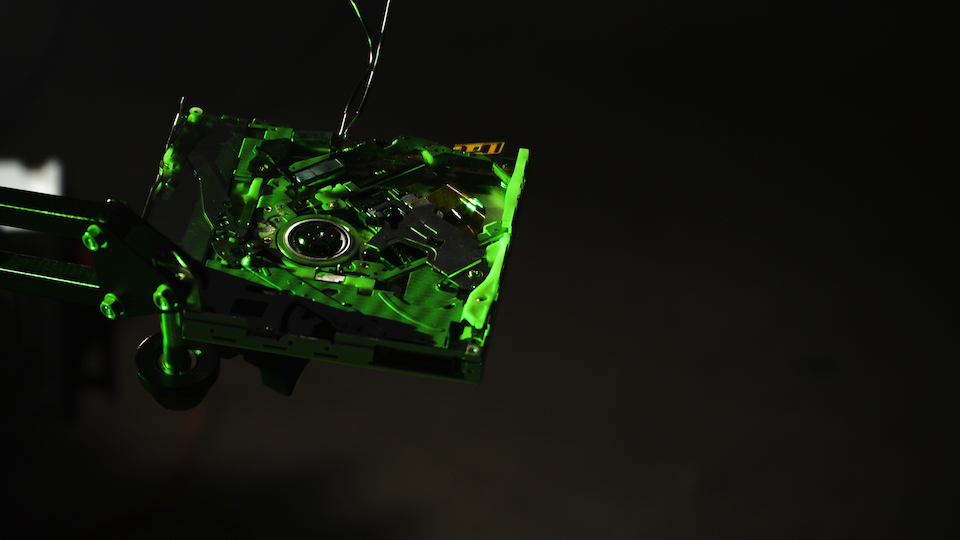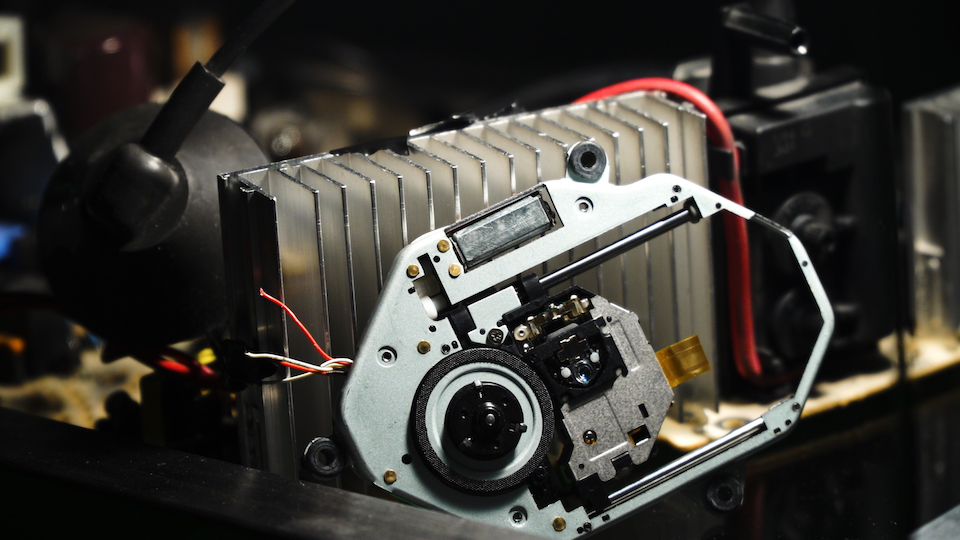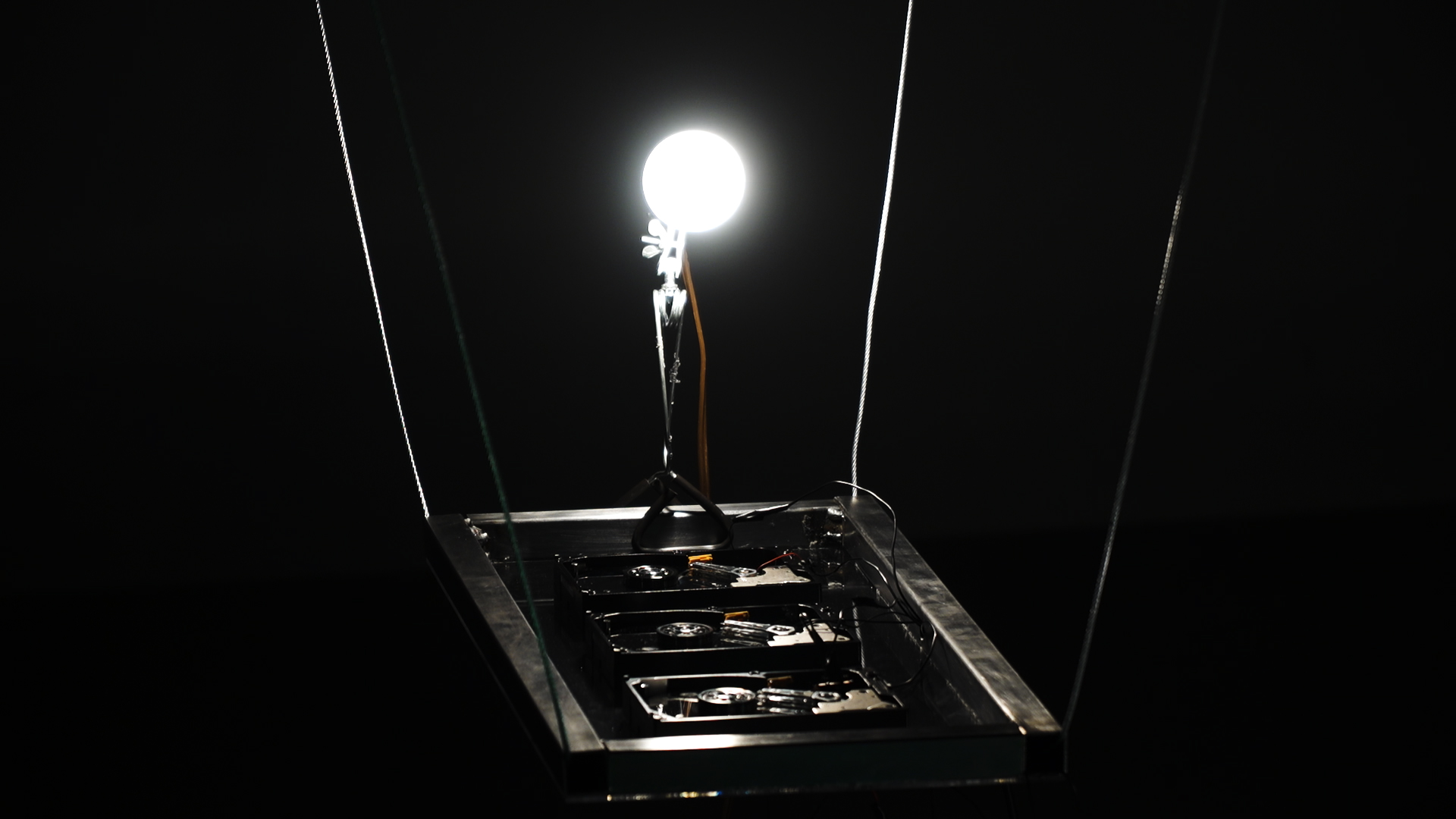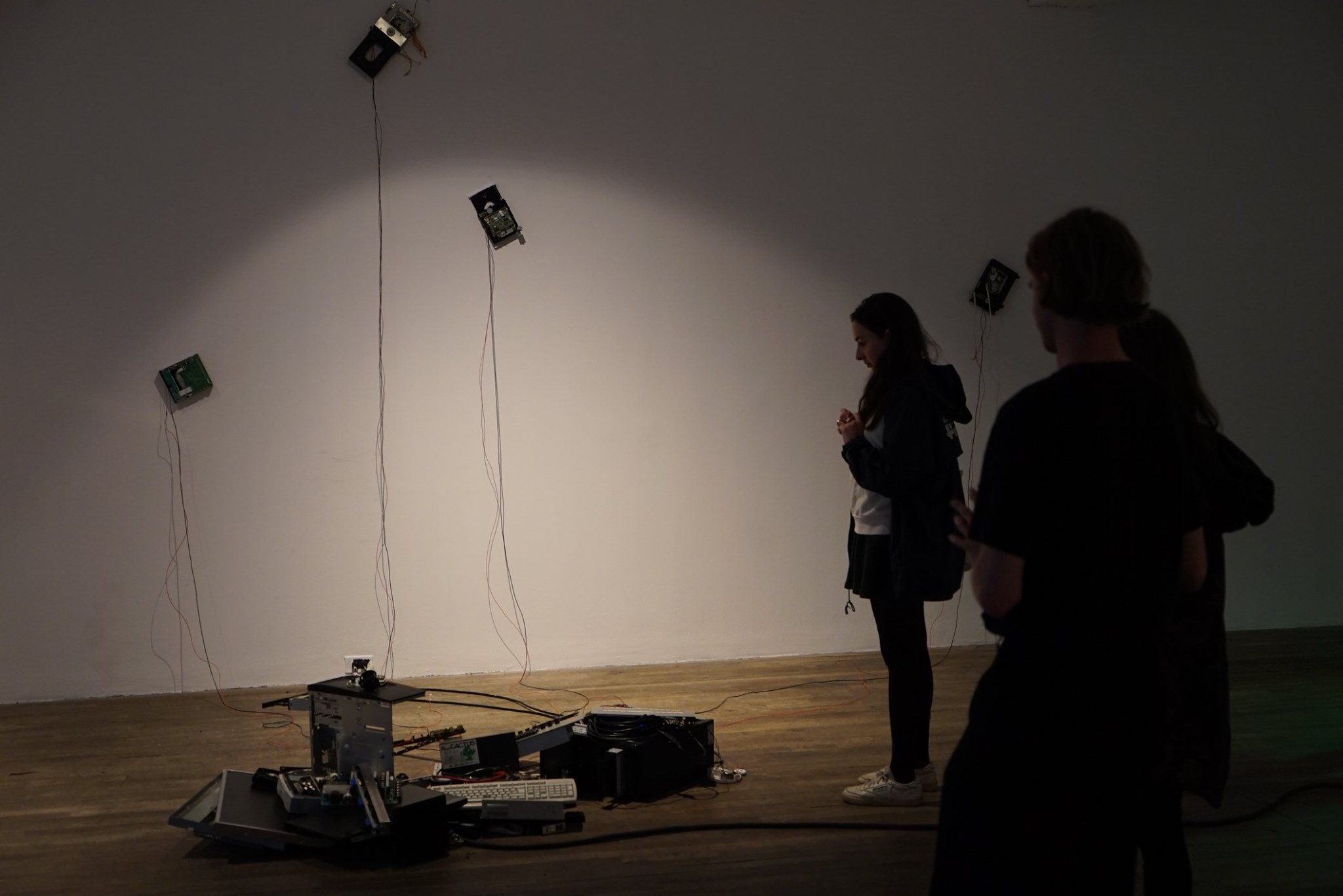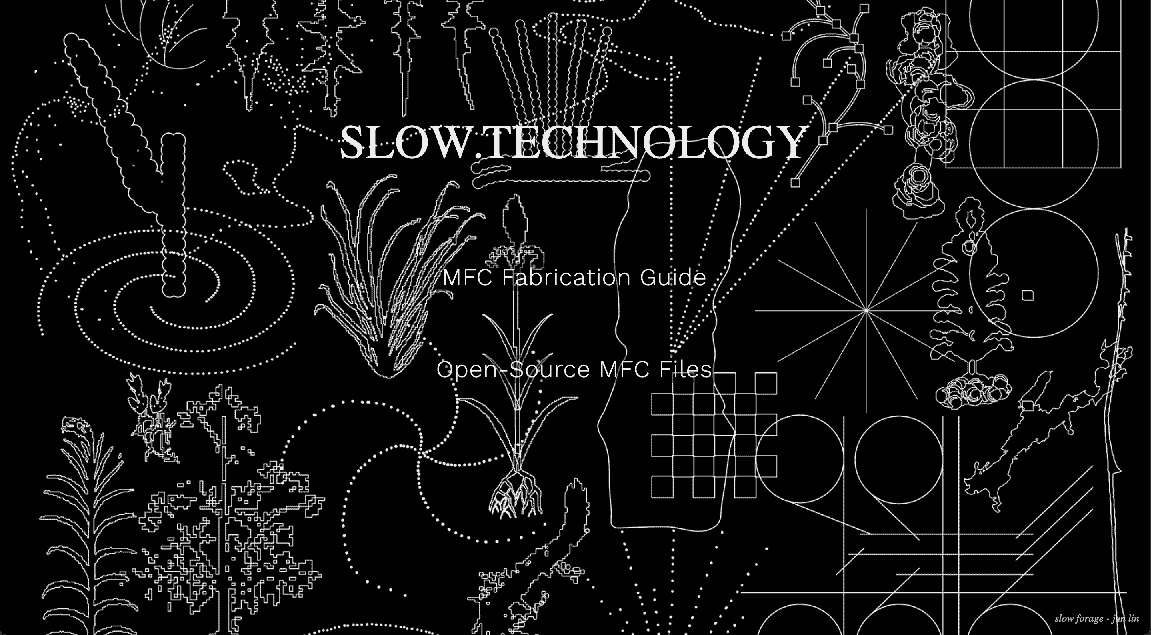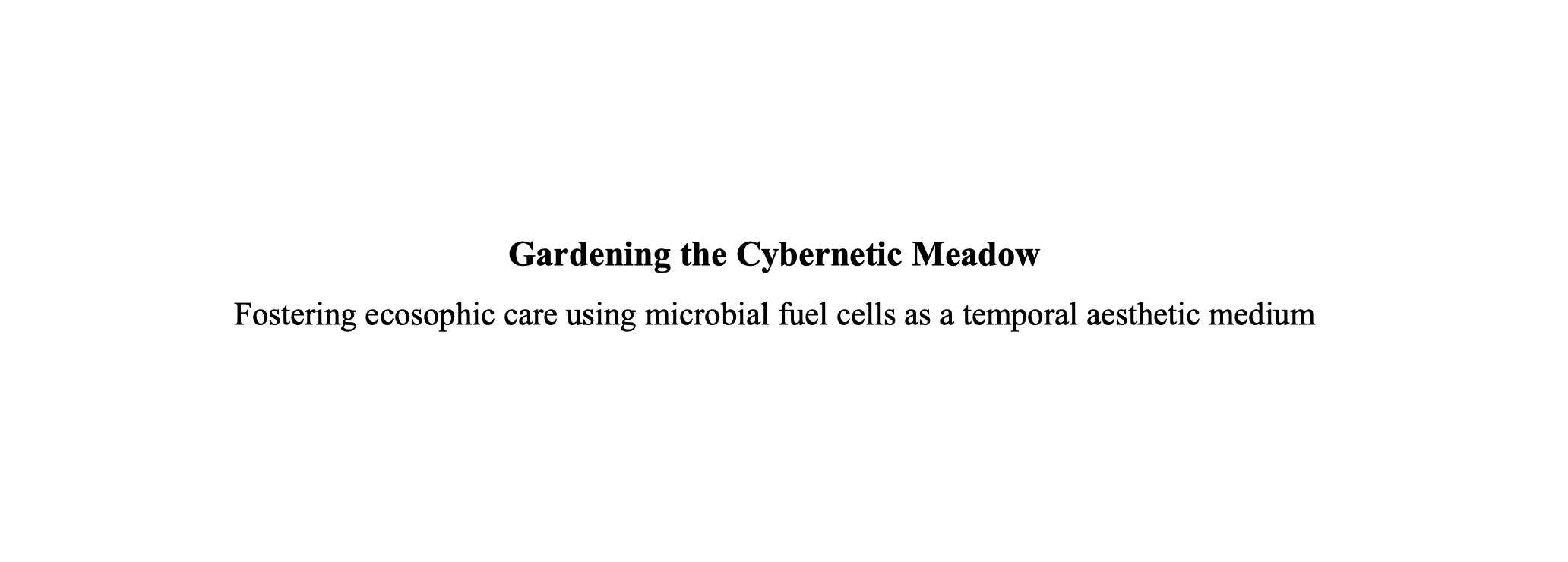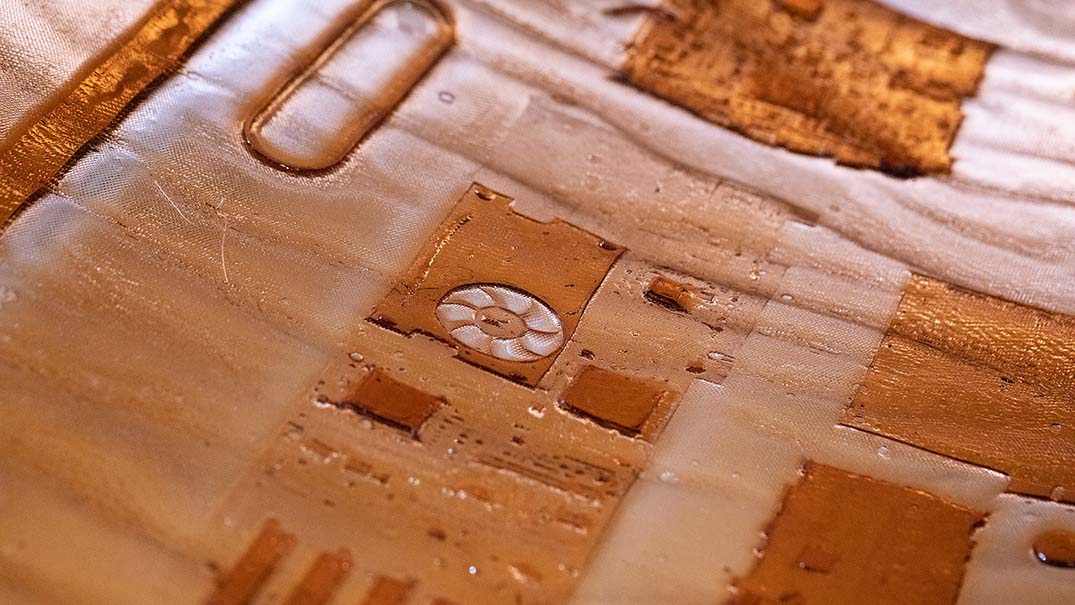
Fossilation, 2021bio-plastic / residual energy installation
duration: 1 month
EXHIBITIONS
Oscillation as part of Biennale Némo 2025 @ Canadian Cultural Center, Paris FR
October 2025
Mutek @ Virtual Gallery, Montréal QC
August 2021
Hors
Piste @ Le Centre Pompidou, Paris FR
January 2021
COLLABORATORS
Milieux Institute, EnsadLab et Université de Toronto
Mississauga
Brice Ammar-Khodja, Alexandra Bachmayer, Samuel Bianchini, Marie-Pier Boucher, Didier Bouchon, Maria
Chekhanovich, Matthew Halpenny, Alice Jarry, Raphaëlle Kerbrat, Annie Leuridan, Vanessa Mardirossian, Asa
Perlman, Philippe Vandal, Lucile Vareilles
Ce projet collectif de recherche en art et en design réunit chercheur.es et étudiant.es-chercheur.ses de
trois institutions de référence pour le développement de la recherche–création : l'Université Concordia
(Montréal, avec le réseau international Hexagram et l’Institut Milieux et son Biolab), l'École des Arts
Décoratifs (avec son laboratoire EnsadLab et sa Chaire arts et sciences) et l'Université de Toronto
Mississauga.
La recherche–création permet d'aborder des sujets complexes de notre monde actuel en mettant en œuvre des
moyens et une réflexivité difficilement envisageable pour une personne seule, pour un.e artiste dépositaire
d'une autorité unique. La recherche–création appelle à repenser le rôle et la place des artistes à un moment
où la coopération entre humains, et, aussi, autres qu'humains, est plus que jamais nécessaire.
Ce projet bénéficie du soutien du Conseil de recherches en sciences humaines du Canada, du réseau
international Hexagram et de la Chaire arts et sciences de l'École polytechnique, de l'Ensad et de la
fondation Daniel et Nina Carasso.
SPONSORS
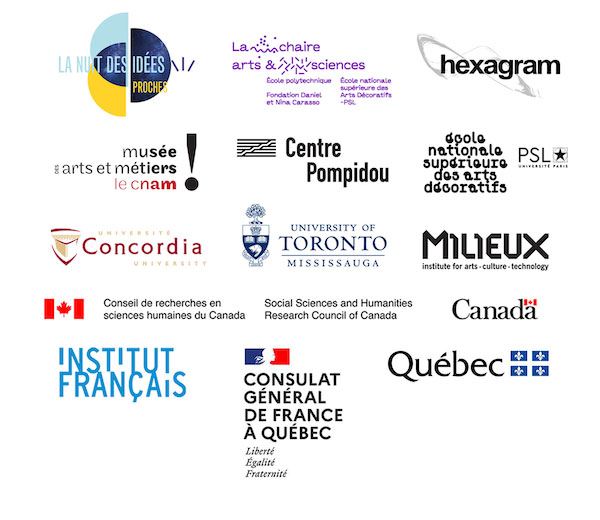
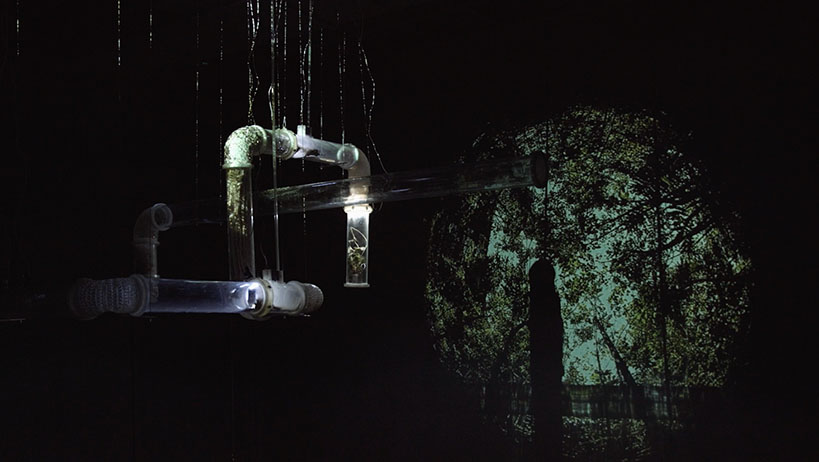
[re]Capture, 2024bio-plastic / residual energy installation
duration: 1 month
[re]capture is carried out as part of the research-creation project “Dynamic flexible membranes: air filtration as an active material, interdisciplinary and environmental process” directed by Alice Jarry (Concordia University) and supported by the Fonds de recherche du Québec - Société et Culture and the Conseil des arts de Montréal. The team would like to thank the City of Montreal Environment Department (Air Quality Division), Patrizio McLelland, Sarah Al Mamoun and Teague Riordon.
EXHIBITIONS
Oscillation as part of Biennale Némo 2025 @ Canadian Cultural Center, Paris FR
October 2025
[re]Capture @ EISODE Generative Arts, Montréal QC
April 29 - May 28, 2024
COLLABORATORS
[re]Capture is a collaborative project between the artists: Alice Jarry, Brice Ammar-Khodja Jacqueline Beaumont, Jean-Michaël Celerier, Matthew Halpenny, Asa Perlman, and Philippe Vandal.
SPONSORS
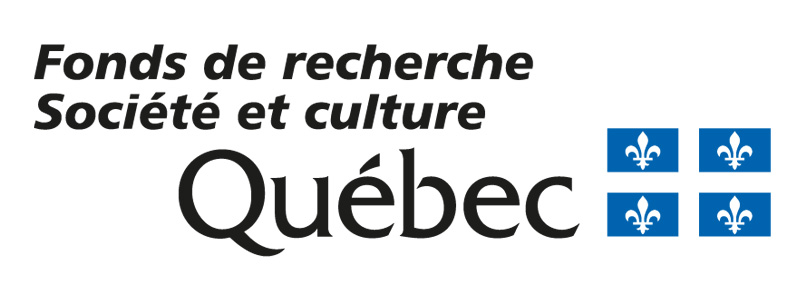

Proprionetics, 2018 cybernetic performance
duration: 10-15 minutes
Proprionetics is a wearable technology project designed for artists and created to liberate the user from relying on their computer for performance. The goal of this technology is to bring performance gesturalism and unique gestural style back to electronic performances, which has been lost in contemporary electronic music. Built over a period of eight weeks, the first prototype of Conductivity utilizes a sum of 12 sensors that respond to 3D positioning in space. It can sense movement, rotation, NSWE positioning and gestures. All of these real-world sensor readings are passed to a personally crafted synthesizer built within the Max MSP environment. A second, wireless version is ready for production.
EXHIBITIONS
Art Matters: (dis)Connect @ Espace
POP, Montréal QC
March 2018
CUJAH Conference: (dis)Connect @
Concordia University, Montréal QC
March 2018
PREVIEW
SPONSORS


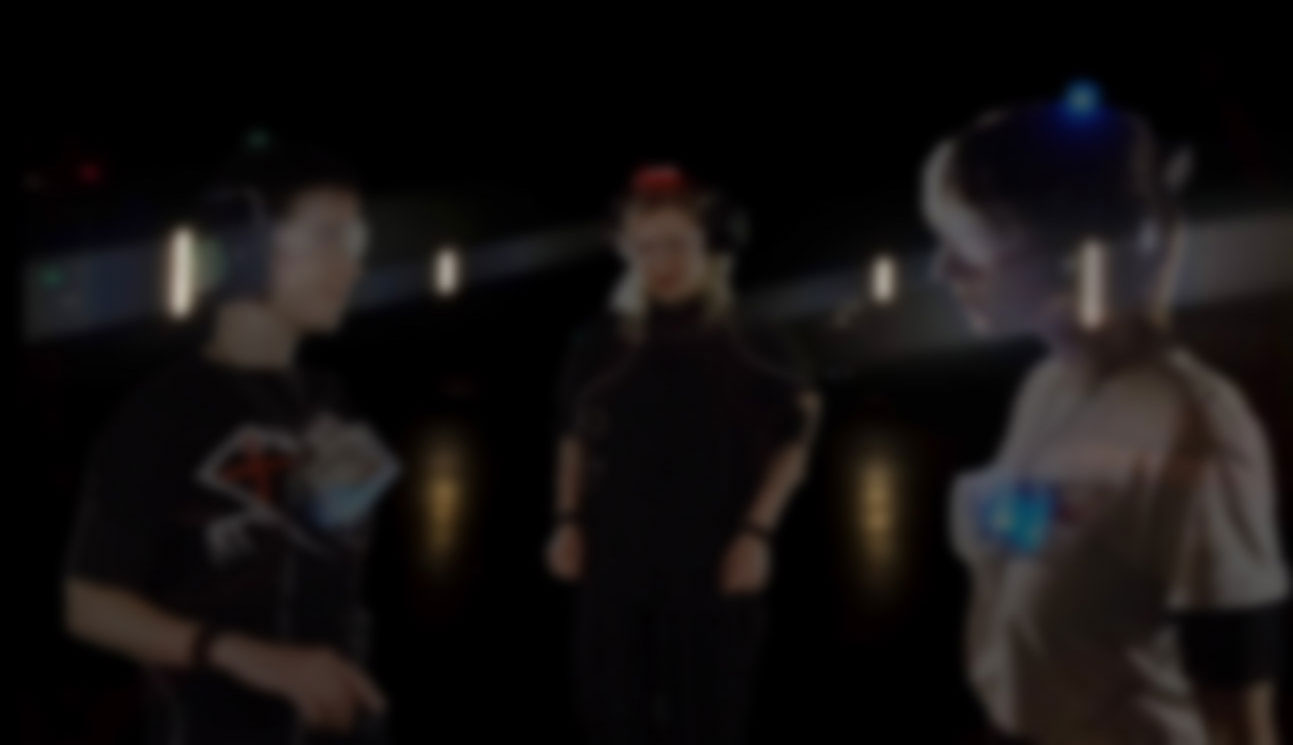
Sensenet, 2019 emergent performance
duration: 5-10 minutes
Sensenet is a concept piece realised as an experiential installation: it is centered around emergent agency
within art, inspired by the neuroscience theme of how timing affects synchrony in networks. Emergent behaviour
is
a property in which the artwork acts and behaves in a way outside the creators intent, and correspondingly,
Sensenet will create an environment of unknown variables in which the participants are left to explore in a
novel and disrupted state of perception. Furthermore, timing in synchrony is a motif that appears across
different levels of neuroscience investigation, from simple learning rules at a cellular level to
whole-brain oscillatory activity; it is an idea that has captured the imagination of wide audiences, making
it an ideal subject for abstraction and artistic exploration.
Three participants enter the environment of Sensenet muted from their own senses; others are welcome to
observe the participants in Sensenet. Each participant is equipped with a lightweight suit that is networked
to all other suits, such that the senses of one participant are effectively swapped with the other
participants; this enables one person to experience a warped perception of their senses. A synchronous
stimulus delivered to all three participants (flashing LED lights in the environment) unifies timing across
the participants, allowing each of them to synchronise the different, mismatched senses into a unified
perception.
Created by:
Matthew Halpenny,
Matthew Salaciak,
Owen Coolidge,
Zahraa Chorghay,
Nailia Kuhlmann
EXHIBITIONS
Bridges:
A SciArt Exhibition @ Mozilla Fest [Virtual]
March 2021
Convergence
@ Hexagram Black Box, Montréal QC
April 2019
PREVIEW
SPONSORS


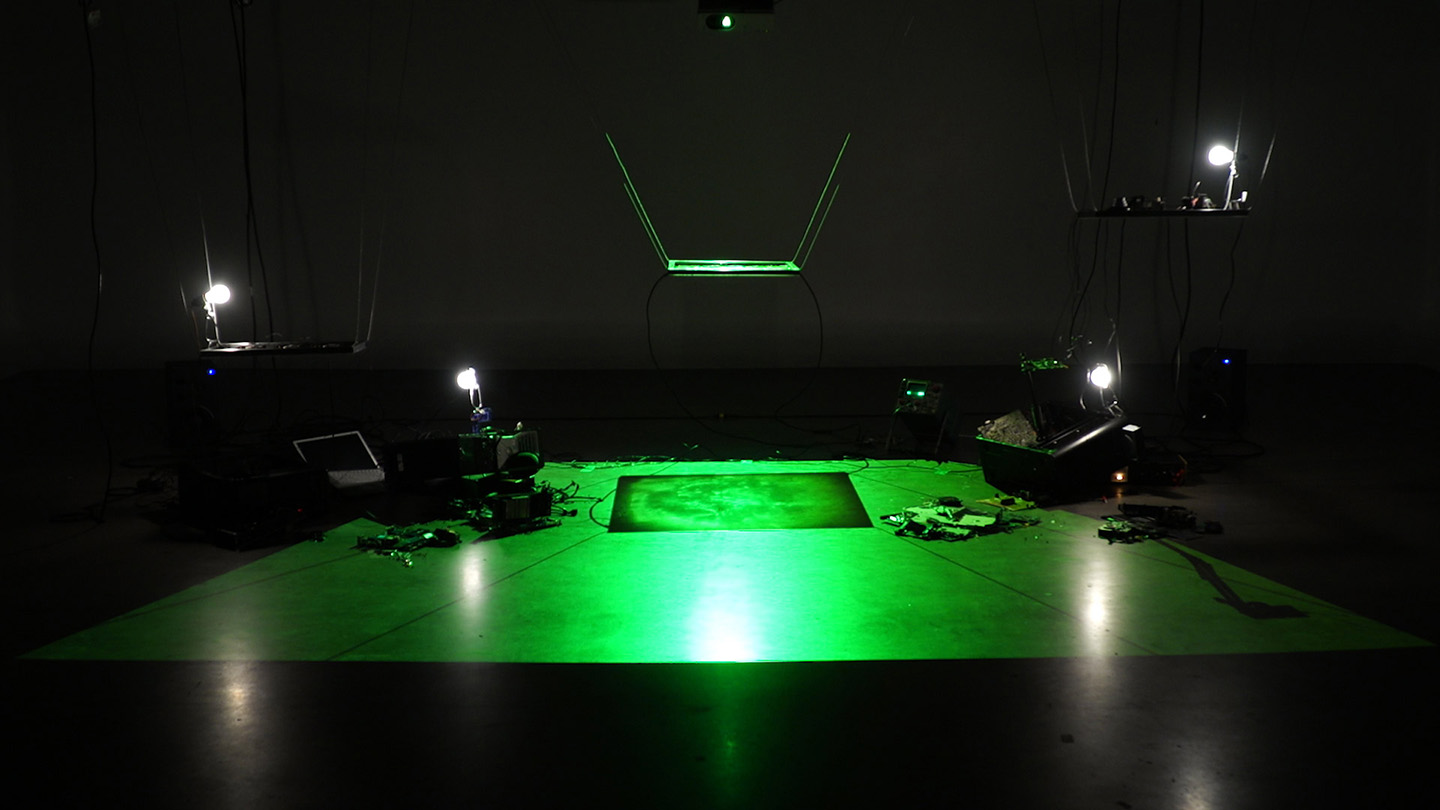
Mycocene, 2019 bio-kinetic sculpture
duration: 1-2 weeks
Mycocene is a room sized installation consisting of reanimated electronic waste sculptures and a live cell
culture, all occupying a shared dimly lit space. Mycocene uses a juxtaposition of bio-art and electronic
(kinetic) sculpture to critique our relation to technology, one that largely ignores the ecological impact
technology has on the Earth. Using a mixture of reclaimed electronic waste and the fungal-esque organism slime
mold, Mycocene acts as a hybrid between the living and the technological world.
The room of Mycocene contains five electronic waste sculptures all separated but in communication with the
slime mold. The slime mold is centered in the room, bathed by a spotlight of green light that emanates to the
remainder of the room. The e-waste sculptures, positioned around the cell container are separated by dimly
lit, relying on the green glow of the slime mold to outline their components. Each of them are actuated by an
electronic pulse modelled off the live growth and movement of the slime mold. The two are intertwined,
creating a living atmosphere permeated by the sound of motors spinning, cameras zooming, hard drives spinning.
The atmosphere is disharmonious, yet organic. The soundscape solely relies on the physically audible
(non-curated) actuations of the sculptures. As they jolt to life, the biological pulses of the slime mold can
be heard in the rhythms of the sound echoing through the space. Moving around the dim channels between
sculptures, decaying security cameras start to scan, the frame of a human body emerges onto a CRT screen
buried under wires. Another pulse triggers a melody punctuated by noise and static, as a magnetic tape crawls
along the walls. Surrounded by electronic waste, the singular slime mold culture orchestrates an evolving
performance, using the sculptures as its means of communication with the world.
Created by: somme
EXHIBITIONS
Eco(Systems) of Hope @ Anteism Books, Montreal QC
October 2022
Elektra XX (solo
exhibit) @ OBORO, Montreal QC
June 2019
MIAN – International
Marketplace for Digital Art @ Centre Phi, Montreal QC
June 2019
Behavioral
Matter @ Centre Pompidou, Paris FR
January 2019
PREVIEW
SPONSORS
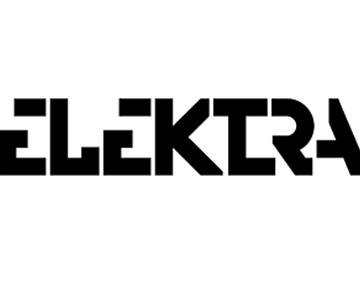
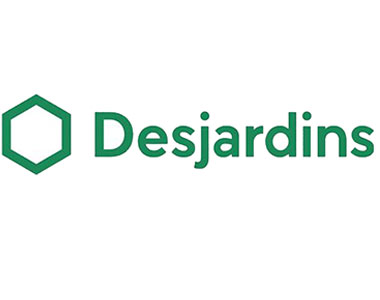

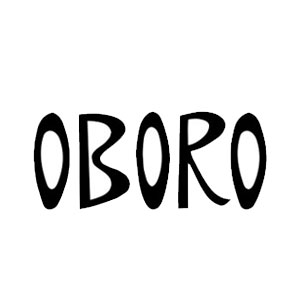
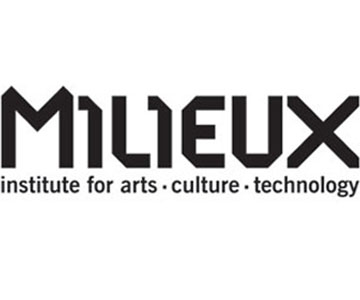



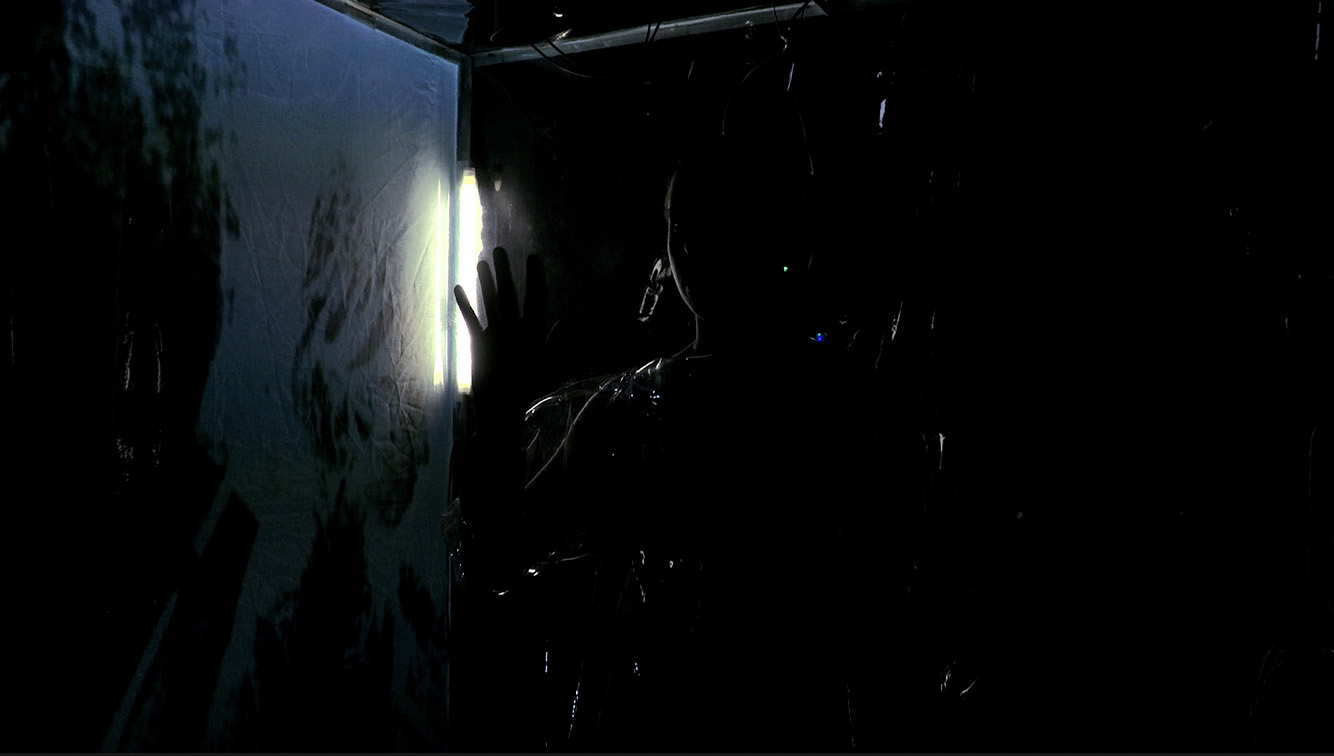
Multiplexer, 2019exhaustive performance
duration: 1 hour
Multiplexer is a speculative performance in which perpetual labor, network processing, and control
protocols are poetically articulated as elements of a closed thermodynamic system.
In this durational piece, the body acts on and is acted upon by its environment. From within a human-scale
structure—a hybrid between a server farm and a greenhouse—
the primary action is the performer’s control of the lighting and sound through the use of a custom
multiplexer panel. Meanwhile, infrared lamps inject heat into the system, acting as concrete metaphors for
the thermal exhaust generated by intense data computation. In this way, the performance investigates the
impact of heat on a biomechanical system. This individual, confined, labors endlessly within a network.
Changes in the performer’s body state are monitored and mediated in real time. Their heartbeat and body
temperature have direct effects on the real-time video, projecting images of the body and its sweat onto the
back wall of the structure; quantifying the performer’s exhaustion. Within this arrangement of perpetual
thermal exchange, the performer’s energy is extracted and injected into the system.
Heat as a medium has theoretical, political, material and environmental implications. In thermodynamics,
heat reveals the qualitative aspect of molecules energy in matter. But heat is often considered as the
undesired waste generated by a system. Heat is now controversial. Within this framework, Multiplexer
establishes a speculative context that challenges human digital behaviors and their collateral effects on
the biological and geological. Taking place in a fictional future where individuals and machines are
mutually dependent parts of closed systems, this piece examines the inherent exhaustion of such
arrangements.
Created by: somme
In collaboration with: Jeremy Michael Segal
PREVIEW
SPONSORS


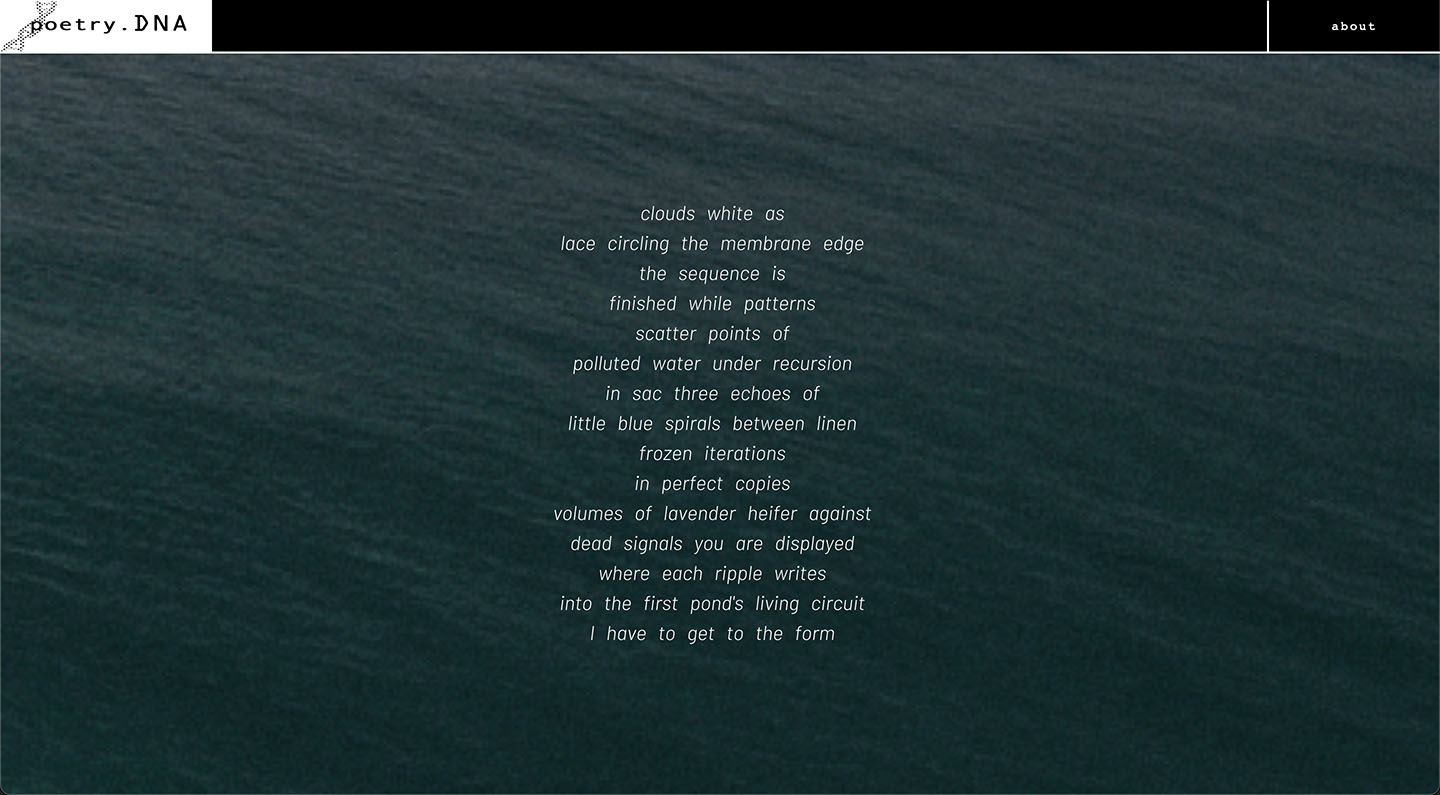
poetry.DNA, 2018Network Mutations - Genetic Poetry
duration: ongoing
Poetry.dna explores the relationship between the organic and the mechanical.It is a generative poetry bot
that is modelled after the biological principles of evolution, mutation, and self-regulation. Inspired by
artificial intelligences that learn based on associative phrasing (such as twitter bots) this project is given
the capacity to create unique phrasing, wording, and formatting to poetry on it’s own accord. This ability is
passed on through JavaScript where Poetry.dna is given a large array of data about the English language and
the use of mathematics such as Markov chains (thanks to RiTa.js). What makes Poetry.dna different is it has no
end goal. Most modern AI learns through a process that involves reward systems upon correct identification.
Poetry.dna does not learn in the sense one might traditionally expect from an AI, instead of a static
algorithm that dictates its creative direction it was instead modelled after nature. True evolution does not
have an end goal, when a mutation occurs the organism either dies, or passes on their genes. AI evolution
typically evolves to a specified point, when it reaches that point it is deemed successful. Poetry.dna does
not have an end point, like in nature it evolves at random and does not move solely forwards but possibly
backwards, it is always in a state of flux and self-regulation. It has corrective mechanisms within its
coding, but it is not always guaranteed, much like genetics.
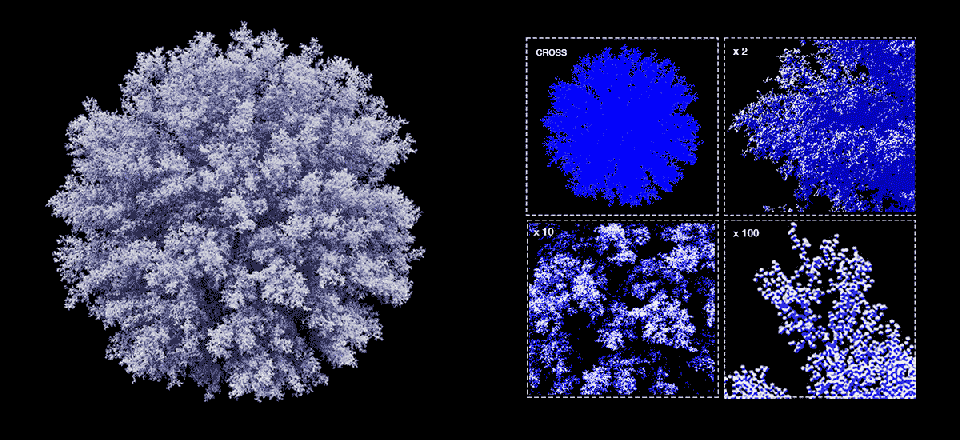
Sense|Spore, 2019 Volumetric DLA Generations
Rendered & Post-Processed A-Life
Through rendering via a process called limited diffusion aggregation, complex shapes can be formed through simulating environmental rewards in a 3D space for artificial cells to seek out, find, and send new scouting cells out from that point of reward. This process can be seen in the growth patterns of organisms like slime mold, or the inorganic growth of certain crystals.
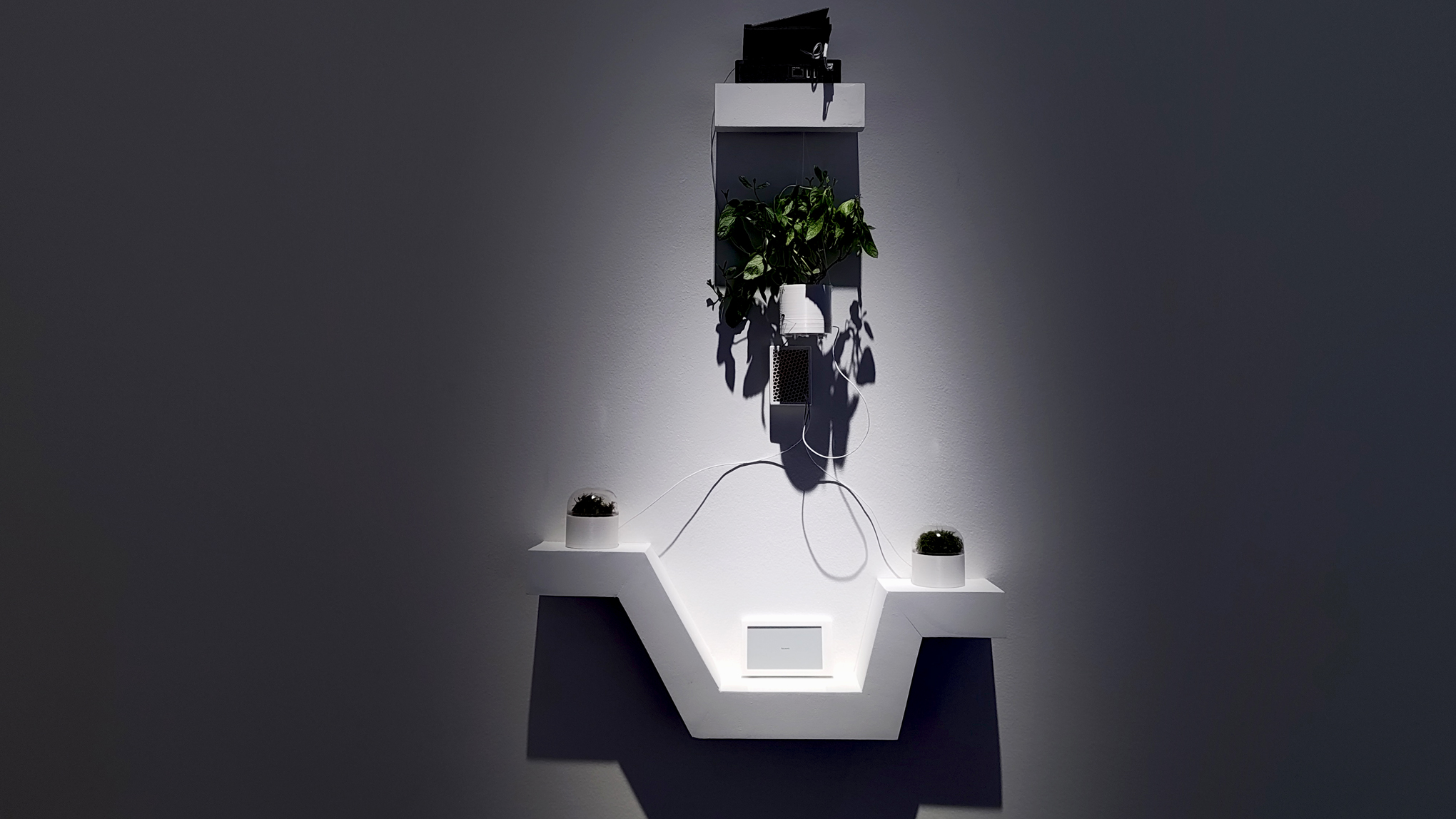
The Cybernetic Meadow, 2024 Slow Text-Gardening Performance
Installation
The Cybernetic Meadow (formerly Slow Serif ) is the installation outcome of "Gardening the Cybernetic Meadow" (2021-2024), a SSHRC funded research-creation thesis project that engages with the fields of interdisciplinary art, ecology, and sustainable energy technologies that draw residual energy from bio-matter (soil microbes). It’s full title, "Gardening the Cybernetic Meadow: Fostering ecosophic care using microbial fuel cells as a temporal aesthetic medium", communicates several core philosophies that inform the work, while outlining how the technical research on microbial fuel cells is situated inside the art-creation of the project.
The installation is a participatory, slow performance installation centered around notions of the extractive energy paradigm, environment-technology relationalities, and slow temporal aesthetics through gardening. The garden requires collective acts of care and maintenance to sustain the work’s creative output, a series of slowly generated texts taking the forms of novellas and poetry. The Cybernetic Meadow operates as a system where its living components and digital technologies cannot be removed from one another. Each component influences the system and, through this, the outcome of the performance. Each garden seeded for a new performance will result in an emergent outcome distinct from any past iterations. The outcome is not static, it exists throughout the growth of the garden, the evolution of the texts, and the social participation sustaining the garden through invitations to care for the garden.
EXHIBITIONS
Oscillation as part of Biennale Némo 2025 @ Canadian Cultural Center, Paris FR
October 2025
Gardening the Cybernetic Meadow @ World Creation Studio, Montréal QC
March 2024
Digital Ecologies @ University of Bonn, Bonn GER
July 2022
FULL DESCRIPTION
The Cybernetic Meadow's process is embodied by a garden interwoven with Microbial Fuel Cells and digital technologies, such as E-Ink screens, microcontrollers, and a solar server. Microbial Fuel Cells (MFCs) are a regenerative energy harvesting technology working in tandem with other-than-human organisms to collect energy. The process they use to harvest energy cannot be removed from the ecosystem they exist within. Microbes within the soil of the garden produce ions as a metabolic by-product during their growth, which is sustained through the photosynthetic processes of the plants and mosses living within the soil. MFCs gather energy through extremely slow means relative to capital-centric extractive models of energy production (i.e., oil & coal). Extractive energy practices are environmentally devastating through their physical destruction of ecosystems for material gain, their emissive by-products, and the inability to renew what is extracted. In contrast, the energy collected through MFCs is regenerative, slowly growing the ions used rather than extracting them.
The slow temporality of this regenerative energy creates the temporal aesthetic conditions within The Cybernetic Meadow. The ions produced through microbial metabolism are slowly accumulated by the electrodes of the MFCs and stored in an energy capacitor, a battery-less energy reservoir. A tactile switch sits in front of the garden, connected to the power circuit of the MFCs. The switch communicates with the digital technologies of the garden when toggled, triggering a creative cycle that adds a single word to the textual outputs. Only when the garden’s reservoir is full can the switch be toggled by a participant, it cannot be pushed beyond this temporal constraint. If it were, extracting a surplus of energy would result in a depletion of soil and microbial health. The textual outputs and digital technologies are directly linked to the growth, health, and energy temporality of the organisms they share the garden with.
The texts are displayed on three E-Ink screens within the garden, generated through a natural language algorithm that are trained a selection of books and papers thematically linked to the installation, such as Geology of Media by Jussi Parikka (2015), Another Science is possible: A Manifesto for Slow Science by Isabelle Stengers (2018), and Slow Violence and the Environmentalism of the Poor by Robert Nixon (2013). The texts used as reference for creative generation are stored on the garden’s solar server, allowing new additions to be continually added through participant recommendations, furthering the emergent potential of the creative text generations through an evolving set of literary influences.
To fully experience the created texts, one must return to the garden to witness progress, encouraging the development of slow, ongoing relationships between participants and the artwork. Through the experience of watching The Cybernetic Meadow’s garden slowly compose creative texts on extractive energy paradigm, environment-technology relationalities, and slow temporalities of care, the performance invites a reflection on how our use of digital technologies and our temporal expectancies of energy, are bound to environmental health and sustainability.
SPONSORS

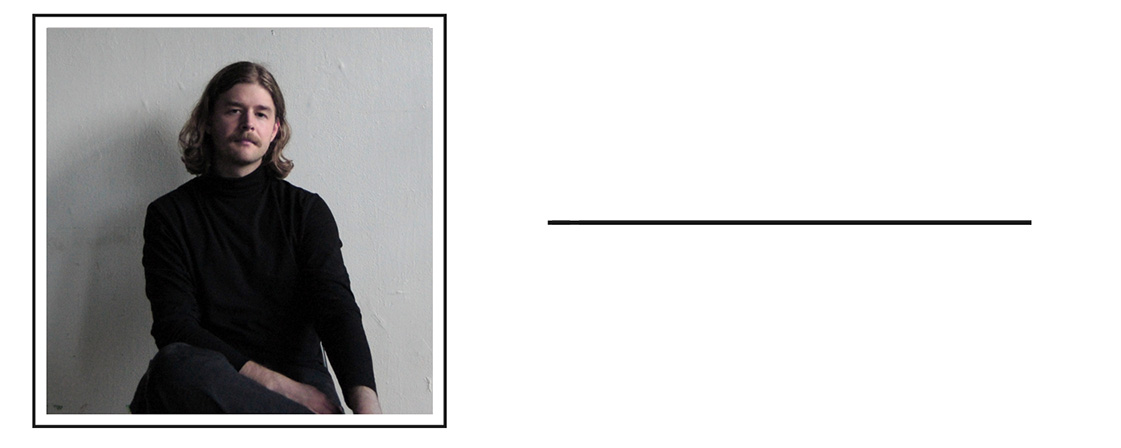
Matthew Halpenny is an interdisciplinary media artist from Montréal who works between the milieus of biology and technology. Their current work examines the embodied material processes that form the technology we use daily while offering speculative design solutions that deconstruct academic barriers between new sustainable technologies and the general public through open-source designs.
Their on-going artistic process is inspired by both theory and the material. It is informed by systems theory, embodied cognition, sense theory, emergent behavior and social/biological ecologies and formed by a range of materials such as networked electronics, sensors, slime mold, microbial fuel cells, e-waste, and bio-plastic printing. These influences have manifested as both installations and performances ranging from using the body as a performative instrument, bio-technological sculpture, open-source speculative design and networked sensory performances.
They were previosuly a research member at Milieux Institute for
Arts, Culture, & Technology, where they worked within the Speculative
Life
and Critical Materiality research clusters. During this time they were a research assistant for Alice Jarry, where they collaborated on
the research-creation project Membranes, resulting in the installation Fossilation at Le Centre Pompidou; and NOMAD Air Kit, exhibited through the installation work [re]Capture. In 2024 they published the culmination of their art-research investigating embodied energy, media materiality, and regenrative technologies using microbial fuel cells as their medium. The work expands beyond the traditional weight given to written modes of sharing knowledge (i.e., thesis dissertatons), and includes alternative modes such as situated knowlede, social mobilizations, and open & replicable toolkits. Their work converged into three dissemenation streams - an exegesis, a DIY fabrication guide and open-source microbial fuel cell designs, and an installation work centered aroud the temporal asthetics of energy through the slow, embodied, process of gardening regenerative technologies. Their individulaized thesis (M.Sc. in Research-Creation), Gardening the Cybernetic Meadow, was completed at Université
de Montréal, where they also worked as a research member of Hexagram and the Critical Gardening Collective.
They co-founded the collective somme in 2018, producing work until 2024. somme was an interdisciplinary group on artists with multi-faceted disciplinary backgrounds such as performance art, biology, engineering; co-founded with Sam Bourgault, Owen
Coolidge, Matthew Halpenny, Matthew Salaciak, and Emma Forgues. Their diverse individual backgrounds
allowed them to collaborate on projects that lie between programming, biology, robotics, video and sound
synthesis. Driven by research-creation questions surrounding biological-technological relations,
surveillance, and data politics, the work the collective produced were a hybrid of
bioart, robotic sculpture, and networked performance art.
somme was awarded the Caisse Desjardins New Media Creation Grant (2018) for their work Mycocene. The
project was subsequently shown in Elektra XX (2019), Printemps Numerique (2022) and was presented at International
Marketplace for Digital Art (MIAN)and Le Centre Pompidou (Behavioural Matter, Alice Jarry) in 2018.
Their research portfolio involves a residency at MilieuxBauhaus (2019) as part of the Bauhaus100 research study, Vision in Motion:
Moholy-Nagy, a paper on technological-biological system relations that was published through ISEA 2020
(2020), a workshop on open-source microbial fuel cells at Ars Electronica (2021), panel moderation for LASER (2022), and many more research projects in the works.
Email: matthew.halpenny@gmail.com
M.Sc. Thesis - PDF
PANELS & PRESENTATIONS
Mattering Energies | Material Assemblages before and after the Human
Biennale Némo 2025 - Canadian Cultural Center, Paris FR
October 18, 2025
Re-situating: more-than-human | Art-Sci Discussions
ArtSci Salon - rare Charitable Reserve, Cambridge ON
May 7, 2023
MATERIA : Laboratoire public de création de savoirs numériques
Elektra x Hexagram - Îlot Balmoral, Montréal QC
September 10, 2022
Open Source Microbial Fuel Cell Project
Digital Ecologies Conference - University of Bonn, Bonn GER
July 29, 2022
Laser 11 – Distributed Greenery [Moderator]
Hexagram - Montréal, QC [Virtual]
April 13, 2022
Hexagram - Fossilation (2021)
Mutek Forum - Montréal QC
August 20, 2021
Bridges: A SciArt Exhibition
Mozilla
Fest 2021 - Mozilla Organization [Virtual]
March 8, 2021
Reprise de Vues
Hors Piste - Le Centre Pompidou [Virtual]
January 28, 2021
Face aux troubles de l’urgence écologique, la lenteur et la durabilité comme mode de
production et de création
HTMLLES festival: Slow Tech -
Ada X [Virtual]
November 26, 2020
Ecologies of Experience: Systems & Art
Convergence SciArt -
Concordia University [Virtual]
October 30, 2020
Designing
Technologies for a Symbiosis between Natural Systems and Digital Infrastructure
ISEA2020 - Printemps
Numerique [Virtual]
October 15, 2020
MIAN –
International Marketplace for Digital Art
Elektra XX - Centre Phi
(Montréal QC // Tiohtià:ke)
June 14, 2019
(Dis)CONNECT: Alienation and Art
CUJAH Conference - Concordia University
(Montréal QC // Tiohtià:ke)
March 21, 2018
WORKSHOPS
[re]capture: Bio-Materialization of Air Pollution
Speculative Life (Concordia University) - Montréal, QC
March. 24, 2023
Introduction to 3D Printing Workshop Series
World Creation Studio - Montréal, QC
Nov. 25, 2023 || Dec. 2, 2023
Emergenc-y: Living Materials Workshop
Ars Electronica - Vienna, AT [Virtual]
September 9, 2021
BioCircuitry: Slime Mold Networks and Computational Models
Milieux Workshop Series - Speculative Life BioLab Montréal, QC
April 16, 2019
PUBLICATIONS
Gardening Regenerative Energy: An Integrated Systems Approach to Sustainable Technologies
Published in: Whole Earth Redux (Special Issue, Whole Earth) | Publisher: Gray Area
2025 (In Press) | Article [Author]
Gardening the Cybernetic Meadow: fostering ecosophic care using microbial fuel cells as a temporal aesthetic medium
Published through: Papyrus (Open Access), Université de Montréal
2024 | M.Sc. Thesis [Author]
Slow Serif | A Conversation
Published in: Ki Journal, Issue 2 - Qui Parle
2023 | Journal [Co-Author, w/ Brennan McCracken]
Form taking/force shaping
Published in: Antennae, Issue 59 - Microbial Ecologies
2022 | Journal [Contributor, p. 58-73]
Fossilation: Nurturing Slow Expectations
Published by: Living Architecture Systems Group, Riverside Architectural Press
2022 | Book [Co-Author, Fossilation Collective]
Designing Technologies for a Symbiosis between Natural Systems and Digital Infrastructure
Published by: ISEA2020 - Sentience
2020 | Conference Proceedings [Author]
PRESS
Digital Ecologies: Mediating more-than-human worlds
Authors: Oscar Hartman Davies, Adam Searle, Jonathon Turnbull, Eva Haifa Giraud
2024 | Book [Manchester University Press]
Digital Ecologies in Practice
Authors: Oscar Hartman Davies, Adam Searle, Jonathon Turnbull
2024 | Journal [Special Issue]
The Slowness of Digital Ecologies in Practice
Author: Noemi Duroux
2022 | Article [Conference Proceedings]
Humaniteq Podcast: S2E2 Terre
Creator: Oriane Morriet
2022 | Interview [Podcast]
DEMO9 Matthew Halpenny – Workshop on Microbial Fuel Cells
Written by: Hexagram Network
2021 | Article [Artist Highlight]
At the convergence of art and science, ecology becomes an experience
Author: Sophia Gorbounov (McGill Tribune)
2020 | Article [Paper]
